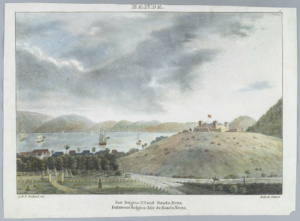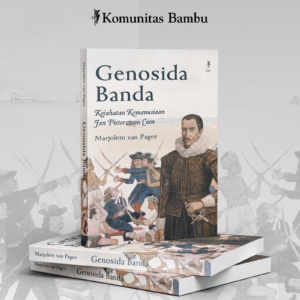New book offers new perspective on Banda massacre
A recently published book captures not only VOC governor-general Jan Pieterszoon Coen’s cruelty in his attempt to monopolize the nutmeg trade in Banda, but also emphasizes the side of the story from the Bandanese diaspora who fled prior to the horrific Banda massacre in 1621.
The Jakarta Post, Text: Nur Janti, March 18, 2024

More than 400 years after the Banda massacre, Bandanese people have revealed in the book Genosida Banda (Banda Genocide) by Dutch historian Marjolein van Pagee, how their ancestors escaped from the bloody events and managed to keep their culture alive.
Banda was famous for the nutmeg that was cultivated on five islands of the Banda group, namely Greater Banda or Lontor, Naira, Run, Ay and Rozengain. It was a dominant region in the spice trade in the 17th century, with traders from various parts of the world, such as the Portuguese and Dutch, doing business with the Bandanese.
However, the Dutch attempted to force the Bandanese to sell their nutmeg exclusively to the Dutch East India Company. The horrific incident that followed was known as the Banda massacre in which, VOC governor-general Jan Pieterszoon Coen ordered the killing of thousands of Bandanese in 1621. Thousands more people from the Banda Islands were then forcibly moved to Batavia, now Jakarta, as captives. However, many of the Bandanese managed to escape prior to the massacre.
“Most of the time it’s written that thousands of Bandanese were killed and nobody survived and those who survived were sent as slaves to Jakarta. And that is just not true, they were not in a hurry, they consciously fled because they knew what the Dutch were planning and they wanted to safeguard their family lines, their culture and religion,” Marjolein said.
In her book, Marjolein not only captures Coen’s cruelty in his attempt to monopolize the nutmeg trade in Banda but also emphasizes the Bandanese diaspora’s side of the story.
The book was published in Dutch in April 2021, while the Indonesian version was launched at the Jakarta History Museum on Saturday [January 27, 2024] by the Jakarta-based publisher Komunitas Bambu.

Overhauling colonial depictions
The book notes that before the massacre, Islam had already been well-established in Banda, thanks to the role of Muslim traders. The population that inhabited Banda was also very diverse with traders from Gujarat, Hadramout, Persia, Egypt, Java and China having settled for centuries, with Islam as a supporting factor in the spice trade.
This contradicts the colonial narrative, which depicted the Bandanese as primitive or hostile to each other.
“In the Dutch narrative there is an impression that Banda had been divided before the arrival of the Dutch because of different Islamic alliances,” Marjolein said.
University of Indonesia historian Bondan Kanumuyoso, who also spoke at the book launch on Saturday, said the Islamic identity of the Bandanese was deliberately erased to construct a primitive image to justify the cruel acts committed against them.
Bondan added that Coen’s belief that there could be no trade without war had no basis, as the spice trade in Asia was conducted peacefully before the Europeans came.
“Asian trade networks before the arrival of the Europeans existed peacefully for centuries,” Bondan said.
Coen’s report in September 1623 that the Bandanese had been wiped out and only a few had fled to the surrounding area afterward was misleading because it turned out that a part of the community had migrated before the massacre.
Bondan said that learning from the book on the Banda massacre, historical sources from Dutch archives must be criticized because they maybe biased toward colonial interests.
Coen had tried to erase the culture, history and identity of the Bandanese from their homeland, but failed, as Marjolein found that 1,700 people fled the island to keep their traditions alive.
Prior to the 1621 massacre, many Bandanese, led by wealthier members of the community, migrated to several places including Kei and Seram islands. Among the emigrants was Raja Waer, who along with 600 Bandanese people moved to Kei Island, about 375 kilometers southeast of Banda.
Lukas Eleuwarin, one of the Bandanese diaspora who resides in the Netherlands, said in the book that his ancestors migrated to Kei Island and lived on a hill called Ohoirin, near Dian village, where the descendants of Raja Waer have lived and preserved their historical heritage, such as the “copper book”, which contains histories and family genealogy in Banda since the fifth[1] century, and speak Bandanese to this day.[2]
“The [Genosida Banda] book offers a new perspective based on the testimony of Bandanese descendants,” Bondan said.
However, Bondan noted that as the book used three sources of Bandanese, this opens up space for other historians to explore Banda’s history and the collective memory of the Bandanese community
[1] Correction: must be 7th century, not 5th century.
[2] Correction: In the village of Lukas’ ancestors nobody speaks the Bandanese language anymore. The only places in which the original Bandanese language is being spoken are Banda Elat and Banda Ely on Kei besar, and in some Wandan-kampongs in Tual. In Dian the community is mixed and they do not speak Wandanese anymore. Raja Waer left Banda prior to 1621. While the ancestors of the people in Banda Ely/Banda Elat left because of the genocide. This explains why the history of 1621 is more alive there.
—
Read also:
Containing bias, colonial historical sources need to be criticized

